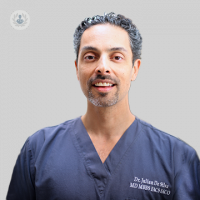What is a facelift?
A facelift, or facial rejuvenation surgery, is an intervention that corrects the most visible signs of facial ageing, by tightening facial muscles, reducing fat, redistributing skin, and eliminating excess tissue. This intervention is usually done under general anaesthesia.

There are various types of facelift, according to the areas of the face treated:
- Upper facelift: elevates sagging brows and eliminates forehead wrinkles
- Middle facelift: which eliminates fat that has accumulated in the cheekbones and lifts the cheeks
- Lower facelift: reduces fat along the jawline and neck (so-called double chin)
Why is a facelift done?
Lax and sagging skin is a clear sign of the passage of time and is particularly visible in the face; in many patients, this can give rise to a complex. Hence, the aim of a complete face lift is to reduce laxity and to restructure the affected areas.
What does it involve?
The procedure is generally carried out by making incisions behind the hairline and behind the earlobe, continuing towards the nape of the neck if necessary, so that scars remain camouflaged. Via these incisions, skin is stretched and sectioned, leaving the face looking firmer and more youthful. Most patients will be surprised to find that the procedure is is not very painful and they only experience little discomfort.
How should I prepare for a facelift?
Before undergoing a facelift, you must follow some important instructions: stop smoking at least 15 days before the operation; for the intervention itself, do not wear contact lenses or make-up and make sure your skin is clean and well hydrated. Furthermore, at the pre-surgery consultation, you will have to tell the surgeon about any medications you are taking and any allergies you have, because more preparation might be necessary.
What does recovery from a facelift involve?
Patients normally leave the clinic 24 hours after the intervention; however this will depend on your evolution and on the surgeon’s recommendation. In the first few days after the intervention, it is recommended to sleep on two pillows in order to reduce the swelling and to avoid drinking hot drinks or chewing too much, so that the stitches are not affected. The swelling and haematomas will disappear over the first few days.
11-13-2012 10-02-2023Facelift
Mr Simon Eccles - Plastic surgery
Created on: 11-13-2012
Updated on: 10-02-2023
Edited by: Conor Lynch
What is a facelift?
A facelift, or facial rejuvenation surgery, is an intervention that corrects the most visible signs of facial ageing, by tightening facial muscles, reducing fat, redistributing skin, and eliminating excess tissue. This intervention is usually done under general anaesthesia.

There are various types of facelift, according to the areas of the face treated:
- Upper facelift: elevates sagging brows and eliminates forehead wrinkles
- Middle facelift: which eliminates fat that has accumulated in the cheekbones and lifts the cheeks
- Lower facelift: reduces fat along the jawline and neck (so-called double chin)
Why is a facelift done?
Lax and sagging skin is a clear sign of the passage of time and is particularly visible in the face; in many patients, this can give rise to a complex. Hence, the aim of a complete face lift is to reduce laxity and to restructure the affected areas.
What does it involve?
The procedure is generally carried out by making incisions behind the hairline and behind the earlobe, continuing towards the nape of the neck if necessary, so that scars remain camouflaged. Via these incisions, skin is stretched and sectioned, leaving the face looking firmer and more youthful. Most patients will be surprised to find that the procedure is is not very painful and they only experience little discomfort.
How should I prepare for a facelift?
Before undergoing a facelift, you must follow some important instructions: stop smoking at least 15 days before the operation; for the intervention itself, do not wear contact lenses or make-up and make sure your skin is clean and well hydrated. Furthermore, at the pre-surgery consultation, you will have to tell the surgeon about any medications you are taking and any allergies you have, because more preparation might be necessary.
What does recovery from a facelift involve?
Patients normally leave the clinic 24 hours after the intervention; however this will depend on your evolution and on the surgeon’s recommendation. In the first few days after the intervention, it is recommended to sleep on two pillows in order to reduce the swelling and to avoid drinking hot drinks or chewing too much, so that the stitches are not affected. The swelling and haematomas will disappear over the first few days.


All about ponytail facelifts
By Mr Foued Hamza
2025-01-29
Did you know that model Bella Hadid's hair in a high, tight ponytail has created an effect that's been replicated by many others? This effect comes in the shape of the ponytail facelift. Internationally-renowned cosmetic surgeon Mr Foued Hamza provides a detailed insight into what's exactly involved in this popular procedure. See more


Can a facelift last 20 years?
By Mr Ayad Harb
2025-01-29
If you’re considering a facelift, there are several factors to carefully consider beforehand. How long will the results last is one of the key questions. Highly distinguished consultant plastic surgeon, Mr Ayad Harb provides a comprehensive overview of facelift aesthetic surgery, ways to make a facelift procedure last longer and what can patients expect from a clinic offering such treatment. See more


Choosing the right facelift: An expert guide
By Ms Monica Fawzy
2025-01-29
Revered consultant plastic surgeon Ms Monica Fawzy gives expert advice on what to consider when deciding which facelift procedure is right for you in this informative article. See more


Facelift and rhinoplasty surgery: what you need to know
By Mr Paul Tulley
2025-01-29
Cosmetic surgery can mean many things, with various procedures that could be done for a number of reasons. Facelift and rhinoplasty are both popular examples that can have an anti-ageing effect. What do they involve? Experienced plastic surgeon Mr Paul Tulley is here to explain and offer expert advice. See more
Experts in Facelift
-
Mr Santdeep Paun
Otolaryngology / ENTExpert in:
- Rhinoplasty (nose job)
- Septorhinoplasty
- Facelift
- Earfold®
- Nasal trauma
- Otoplasty
-
Mr Mo Akhavani
Plastic surgeryExpert in:
- Breast augmentation
- Facelift
- Gynaecomastia
- Tummy tuck (abdominoplasty)
- Liposuction
-
Mr Simon Eccles
Plastic surgeryExpert in:
- Facelift
- Facial reconstruction
- Children's plastic surgery
- Rhinoplasty (nose job)
- Blepharoplasty
- Body contouring
-
Miss Katherine George
Oral & maxillofacial surgeryExpert in:
- Facial reconstruction
- Facelift
- Salivary gland surgery
- Sialendoscopy
- Wisdom teeth
- Orthognathic surgery
-
Dr Julian De Silva
Plastic surgeryExpert in:
- Blepharoplasty
- Oculo-facial plastic and cosmetic surgery
- Facelift
- Rhinoplasty (nose job)
- Dermal fillers
- Neck lift
- See all

Westminster Bridge Consulting Rooms at St Thomas' Hospital Private Healthcare.
Westminster Bridge Consulting Rooms at St Thomas' Hospital Private Healthcare.
Westminster Bridge Road, London
No existe teléfono en el centro.
By using the telephone number provided by TOP DOCTORS, you automatically agree to let us use your phone number for statistical and commercial purposes. For further information, read our Privacy Policy
Top Doctors

111 Harley St.
111 Harley St.
111 Harley Street
No existe teléfono en el centro.
By using the telephone number provided by TOP DOCTORS, you automatically agree to let us use your phone number for statistical and commercial purposes. For further information, read our Privacy Policy
Top Doctors

The Blackheath Hospital - part of Circle Health Group
The Blackheath Hospital - part of Circle Health Group
40-42 Lee Terrace, Blackheath, London SE3 9UD
No existe teléfono en el centro.
By using the telephone number provided by TOP DOCTORS, you automatically agree to let us use your phone number for statistical and commercial purposes. For further information, read our Privacy Policy
Top Doctors
-
Westminster Bridge Consulting Rooms at St Thomas' Hospital Private Healthcare.
Westminster Bridge Road, London , SE1 South Bank LondonExpert in:
- General Surgery
- Orthopaedic surgery
- Plastic surgery, reconstructive and aesthetics
- Endocrinology
- Obstetrics and Gynaecology
- Paediatrics
-
111 Harley St.
111 Harley Street, W1G Marylebone LondonExpert in:
- Breast augmentation
- Plastic surgery, reconstructive and aesthetics
- Facial aesthetics
- Facelift
- Liposuction
- Aesthetic Medicine
-
The Blackheath Hospital - part of Circle Health Group
40-42 Lee Terrace, Blackheath, London SE3 9UD, East LondonExpert in:
- Vascular Surgery
- Cardiology
- Bariatric Surgery
- Colorectal surgery
- Endocrine Surgery
- General Surgery
- See all
- Most viewed diseases, medical tests, and treatments
- HHT (Hereditary Haemorrhagic Telangiectasia)
- Snoring
- Polysomnography (sleep study)
- Chronic headache
- Visual impairment
- Diabetic retinopathy
- Retina
- Presbyopia
- Nystagmus
- Myopia







